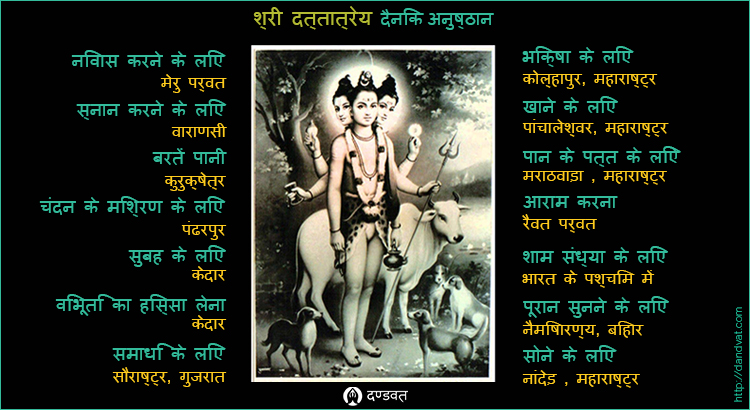Daily rituals of Prabhu Shree Dattatreya

🙏 Dandvat Pranam 🙏
Shree Dattatreya - The Universal Guru. He had descended on this earth to establish three things and beliefs
1. Satya – The Universal Truth.
2. Rta – The Cosmic Order.
3. Dharma – The perennial principles.
Prabhu Shree Datta have numbers of leelas, we cant even count them. Here i'm trying to describe the daily life routine of Shree Datt parbhu in few lines. Hope all you will appreciate and share with the communities. From the start of day to end.
All these prakriyas are taken from the part of leelas done by prabhu ji.
Teachings of Shree Dattatreya MaharajPrabhu Ji gave Ashtanga Yoga (eight fold path of Yoga) to the world thousands of years ago.
Yama – non-killing, truthfulness, non-stealing, continence, and non-receiving of any gifts. Moral discipline.
Niyama – cleanliness, contentment, austerity, study and self-surrender to God. Moral discipline Yama and Niyama are moral training and form the basis of Yoga. As these two become established, the Yogi will begin to realize the fruits of his practice.
Asana – posture.
Pranayama – ‘Prana’ is the life-force, ‘yama’ is control. ‘Pranayama’ consists of breath control exercises.
Pratyahara – withdrawal of senses from sense objects.
Dharana – concentration.
Dhyana – meditation.
Samadhi – the transcendental or super conscious state of being one with God: Principle.
🙏 जय श्री कृष्ण जी 🙏
Shree Dattatreya - The Universal Guru. He had descended on this earth to establish three things and beliefs
1. Satya – The Universal Truth.
2. Rta – The Cosmic Order.
3. Dharma – The perennial principles.
Prabhu Shree Datta have numbers of leelas, we cant even count them. Here i'm trying to describe the daily life routine of Shree Datt parbhu in few lines. Hope all you will appreciate and share with the communities. From the start of day to end.
- 1. Meru Mountain, Uttarakhand – Prabhu G used to reside at Meru mountain.
- 2. Varanasi, Bihar – Prabhu G always take bathe on Ghats of Ganga, Varanasi, Bihar at early morning. Most listened leela of prabhu g is sanan at Ganga ghat. He always do check of his loving people at morning time on the walk to Varanasi.
- 3. Kurukshetra, Haryana – Prabhu G used to Sipping water at the Kurukshetra
- 4. Pandharpur – Shree Datta prabhu G always do the chandan tilak prakriya at Pandharpur.
- 5. Kedar – Prabhu G always do devotional japp at Kedar also called morning sandhya.
- 6. Kedar – Prabhu G partake Vibhuti/Bhasma (ash) at Kedar after the morning sandhya.
- 7. Girnar, Saurashtra, Gujarat – Prabhu G always do meditation in Girnar, Saurashtra, Gujarat.
- 8. Kolhapur, Maharashtra – One of most famous routine of Prabhu G is bhiksha in the Kolhapur, Maharashtra area after the noon.
- 9. Panchaleshwar, Maharashtra – Agin one of most famous and listed leela of Prabhu Shree Datt is takin lunch after bhiksha on the banks of Godavari river.
- 10. Marathwada, Maharashtra – After having luch, Prabhu G use to take roll of betel leaves in Rakshasbhuvan, District Beed, Marathwada, Maharashtra.
- 11. Raivat Mountain, Gujarat, India – Prabhu G takes some rest and Raivat Mountain (Girnar).
- 12. Western Ocean, Bharat – Prabhu Shree Dattatray g after having the rest always spend his time at the western part of Bharat. Generally at the ocean head.
- 13. Naimisharanya, Bihar – Shree Datt prabhu G spend his most of time to hear discourses and kirtans at Naranarayan Ashram in Naimisharanya, Bihar.
- 14. Mahurgad, Maharashtra – At the end of day Prabhu G takes the sleep at the Sahyaparvat in Nanded, Maharashtra.
All these prakriyas are taken from the part of leelas done by prabhu ji.
Teachings of Shree Dattatreya MaharajPrabhu Ji gave Ashtanga Yoga (eight fold path of Yoga) to the world thousands of years ago.
Yama – non-killing, truthfulness, non-stealing, continence, and non-receiving of any gifts. Moral discipline.
Niyama – cleanliness, contentment, austerity, study and self-surrender to God. Moral discipline Yama and Niyama are moral training and form the basis of Yoga. As these two become established, the Yogi will begin to realize the fruits of his practice.
Asana – posture.
Pranayama – ‘Prana’ is the life-force, ‘yama’ is control. ‘Pranayama’ consists of breath control exercises.
Pratyahara – withdrawal of senses from sense objects.
Dharana – concentration.
Dhyana – meditation.
Samadhi – the transcendental or super conscious state of being one with God: Principle.
🙏 जय श्री कृष्ण जी 🙏
🙏 दंडवत प्रणामनमो पंच कृष्ण अवतार
- Author: Dandvat
- Posted on: February 28, 2016 8:00 AM
- Tags: Shree Dattatreya Prabhu, Knowing Mahanubhav Pantha, Mahanubhav Panth Literature, Rituals of Mahanubhav Pantha
